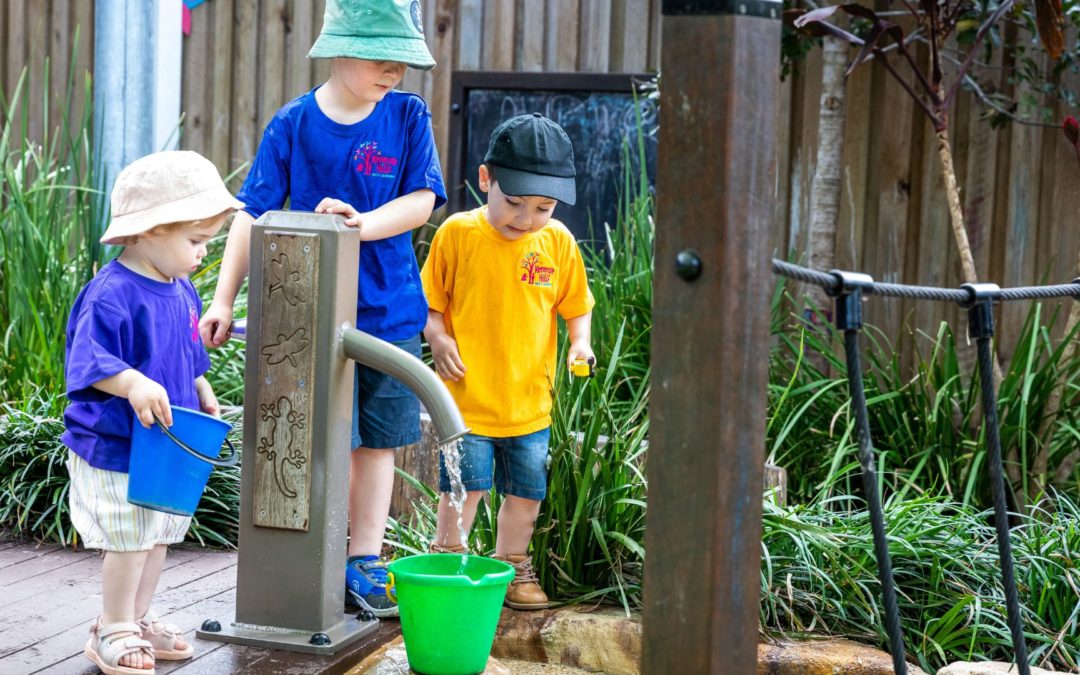Benefits of waterplay for children PLUS ideas to try at home!
Waterplay has many benefits for children, from helping develop children’s gross motor skills to promoting imaginative and creative play. We have gathered some ideas to incorporate more water play at home.
Why waterplay?
Being in water, being around water, touching water, smelling or just seeing water makes us happy. Water is emotional – it can be calming, angry and everything in between. And it is vital to life – after all, we are made up of 60% water ourselves!
So it’s not surprising that you will find children playing at any water trough, fancy water play area, creek bed or beachside across our land. In early learning centres across Australia, in remote indigenous communities, in loud busy cities, where nothing is the same and everything is different, if you add the water, the children will come.
Waterplay at Kenmore Hills Early Learning
Water play is a favourite at our centre and is incorporated heavily into our outdoor playscape. Our spray misters are perfect for those hot summer days in Queensland! Most days you will find a group of children playing with the water pump, barefoot and highly engaged! (Parents – always be sure to send along spare clothes!)
Benefits of waterplay
Waterplay holds limitless potential to engage young minds in meaningful learning experiences, with children themselves at the core. Water itself is a basic element which has no preconceived rules of engagement – there is no one that can tell another exactly what needs to be done with it, similar to sand play or block play. Best of all, it’s free!
- Water is naturally open-ended – supporting children’s curiosity, imagination, and creative freedom.
- Waterplay is a provocation for developing social and language skills.
- It can occur indoors or outdoors.
- Waterplay supports cognitive development, STEM concepts, physical growth and development of children.
- Water is always developmentally appropriate and is exceptionally inclusive of all children – limited only by its context as in how it is used.
- Best of all, waterplay is therapeutic.
It is tranquil and children can play alone or with others, the choice is theirs. Children will get lost in the rhythm of water, scooping it up, putting their hands in it, and watching it move with their hands. Water play allows children to unwind and relax in the gentle repetition water will bring.
Your role in Waterplay learning
Plan and set up water play experiences that encourage thinking and exploration.
A good variety of common items found at home like cups, funnels, small bowls, pipes, sponges, things that sink and things that float, frozen ice cubes with food dye in them, ladles, hand mixers, measuring cups, squeeze bottles, spray bottles etc. Depending on your intention this could change as well, you could add sea animal toys or boats or leaves as well.
Tips
-
- Don’t worry about aprons – they get in the way of fun! Children can easily change their clothes after.
- You can use a specially brought water play table such as this one, a paint tray from the hardware shop, a hose and some buckets, or a table with a variety of random containers to hold water in whatever form.
- You can go outside and play when it rains – nature will provide the resources if you just open the door! Remember there is no inappropriate weather for play, just inappropriate clothing. You might find more ideas for rainy day play here.
- Safety note: Remember to empty out water containers after play
Waterplay could be one of the most child-friendly and fun activities and has many benefits. From the moment they enter a pool or the bathtub, children will splash and play.


Recent Comments